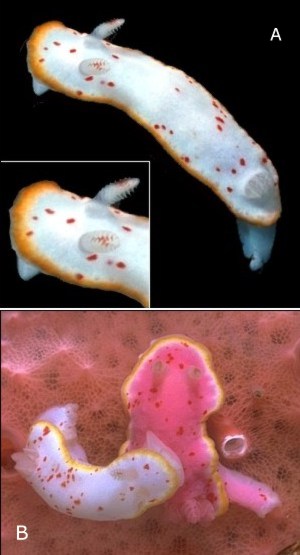
Noumea haliclona
New South Wales colour form
PHOTO
A. Green Point, Sydney Harbour, NSW, 6-9m, Feb. 1980, 10mm long. INSET: Note characteristic red mark on anterior edge of rhinophore club. B. Fisherman's Beach, Twofold Bay, southern NSW, intertidal, March 1986, 1 pink (18mm long), 7 white (4-17mm) on sponge (Darwinella gardineri). C. Juveniles, 2-7mm long, E side of Split Solitary Is., 21m, Coffs Harbour Region, northern NSW, December 1990. On Darwinella cf. australiensis. D. N side of Split Solitary Is., 15m, Coffs Harbour Region, northern NSW, March 1988. 13mm long on Darwinella? sp.. E. White Horse Point, Balmain, Sydney Harbour, NSW, June 1982, approx 10mm long, intertidal on yellow sponge (Aplysilla? sp.). PHOTOS: Bill Rudman.
In New South Wales animals range in colour from pink to white, usually with a yellow border to the mantle, but sometimes in juveniles the yellow border is absent. Green Cape forms a sharp geographic boundary between the NSW colour forms and the pink colour form found in Victoria, probably one of the few examples in the world of a political and biological boundary coinciding.
New South Wales specimens have been exhaustively studied (Avern, 1986) and the background colour is presumably genetically based because it is not the result of uptake of sponge pigment. The presence of direct development in this species and a pink colour form throughout its range, would suggest a southern origin, rather than a recent tropical origin, is more likely for this species. It is possible that the pink Victorian or pink or yellow Tasmanian form is ancestral. Colour in those forms matches exactly their food sponge and can be considered most probably to be cryptic. Similar pink and yellow colour states can be found in the sympatric Verconia verconis. Although the same, or similar, pink and yellow aplysillid sponges are found in NSW, it is of interest that in this region there appears a white colour state. This white state, with red spots and a yellow border is clearly no longer cryptic, and approximates well the predominant red-spotted colour group in this region.
See main Noumea haliclona page.
References:
• Rudman, W.B. (1983) The Chromodorididae (Opisthobranchia: Mollusca) of the Indo-West Pacific: Chromodoris splendida, C. aspersa and Hypselodoris placida colour groups. Zoological Journal of the Linnean Society, 78: 105-173.
• Rudman, W.B. (1986) The Chromodorididae (Opisthobranchia: Mollusca) of the Indo-West Pacific: Noumea flava colour group. Zoological Journal of the Linnean Society, 88: 377-404.
•Rudman, W.B. (1991) Purpose in Pattern: the evolution of colour in chromodorid nudibranchs. Journal of Molluscan Studies, 57, (T.E. Thompson Memorial Issue):5-21.
•Avern, G.J. (1986) The biology of the nudibranch mollusc Noumea haliclona (Burn, 1957). M.Sc. Thesis, University of Sydney (unpublished).
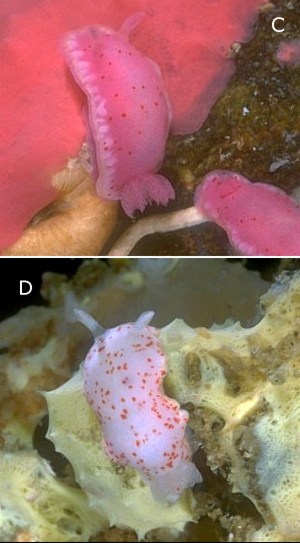
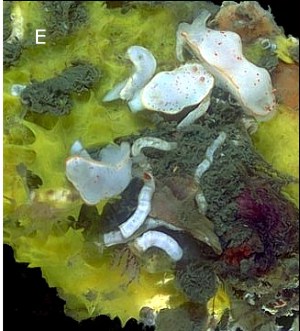
Rudman, W.B., 2000 (May 31) Noumea haliclona New South Wales colour form. [In] Sea Slug Forum. Australian Museum, Sydney. Available from http://www.seaslugforum.net/find/noumhali4
Related messages
Noumea haliclona egg ribbon
January 19, 2009
From: David and Leanne Atkinson
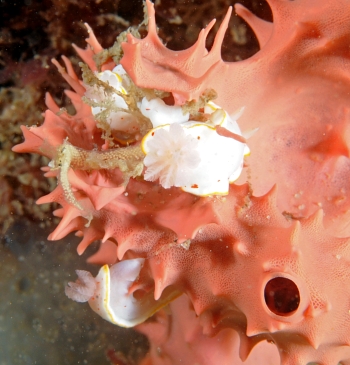
Concerning message #21925:
Hi Bill,
We found the New South Wales colour form of Noumea haliclona feeding on a pink sponge and laying eggs. Sadly we didn't see the eggs until we had the photos up on the computer screen so didn't angle our shots to get them. There are two individuals with eggs and there were five altogether on this sponge.We also have photos of them with their mouth extended onto the pink sponge but theought the egg shots were more interesting and although we can't see them being extruded one shot shows the egg string being shaped with the foot. The eggs seem consistent with the black and white photo of the egg string in your embryology page and the egg strings on an earlier group shot showing colour variations.
Locality: Fly Point, Port Stephens-Great Lakes Marine Park, Port Stephens , 12 metres, New South Wales, Australia, Pacific Ocean, 10 January 2009, Sandy bottom sponges, bryozoans, soft corals, hydroids, ascidians and kelp. Length: 10mm. Photographer: David and Leanne Atkinson.
Regards,
Leanne & David Atkinson
atk@hunterlink.net.au
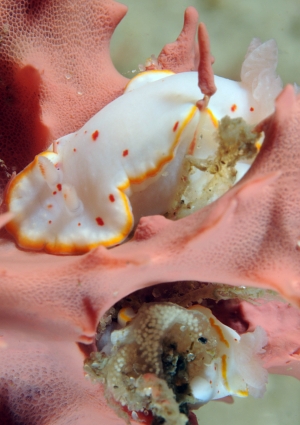
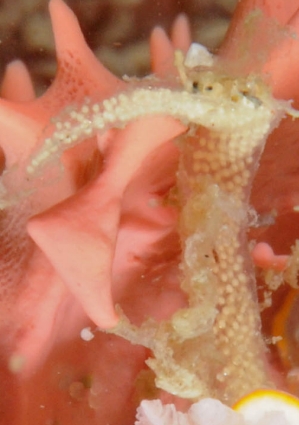
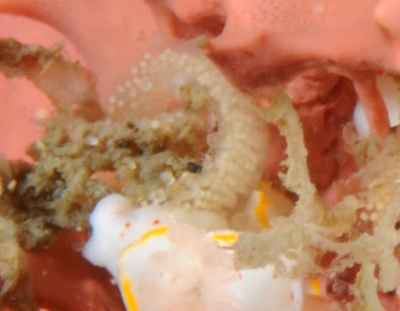
Dear David & Leanne,
Thaks for these shots of the egg strings. I must finish the embryology pages you refer to - I need to add some explanatory notes. Noumea haliclona has direct developing eggs, which as we can see in your photos are relatively large, and lack a free-swimming veliger larvae stage, the hatchlings emerging from the egg capsules as small crawling slugs. The pink sponge, Darwinella gardineri, is one of the group of related sponges that this species feeds on.
You mention this is what I call the New South Wales colour form of the species. When I studied these animals from southeastern Australia I found, as is outlined on the main species Fact Sheet, that there were a number of distinct geographically distinct colour forms, all with what seems to be identical anatomy and reproductive biology. What links all the colour forms together is a red smudge on the front of each rhinophore. If you look at your middle left photo you can clearly see the red mark on each rhinophore.
Best wishes,
Bill Rudman
Noumea haliclona & C. splendida feeding
October 2, 2008
From: L. & D. Atkinson
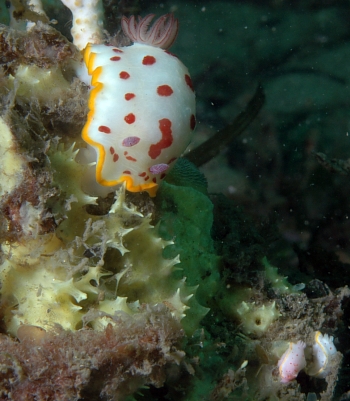
Concerning message #12223:
Dear Bill,
We found these Noumea haliclona and a Chromodoris splendida feeding on a yellow spikey looking sponge. This series of photos shows the comparative size of the two species and two colour forms of the Noumea haliclona. Hope they are of interest, and thankyou as always for your work on the Sea Slug Forum.
Locality: The Pipeline, Nelson Bay, Port Stephens, 5 metres, New South Wales, Australia, Pacific, 29 September 2008, Silty sandy bottom with scattered sponges, ascidians, hydroids, soft corals and sea pens. Length: Noumea haliclona approximately 10 mm and Chromodoris splendida 40 mm. Photographer: Leanne & David Atkinson.
Best wishes,
Leanne & David Atkinson
atk@hunterlink.net.au
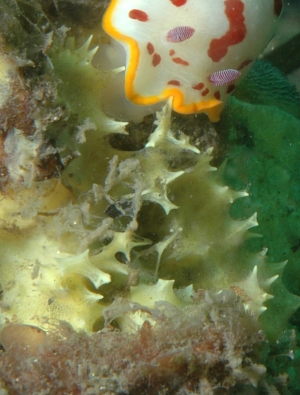
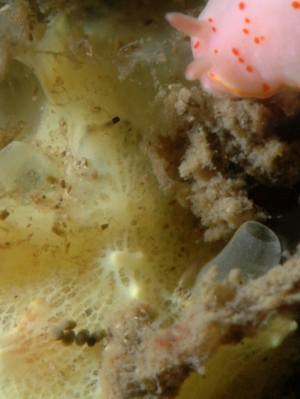
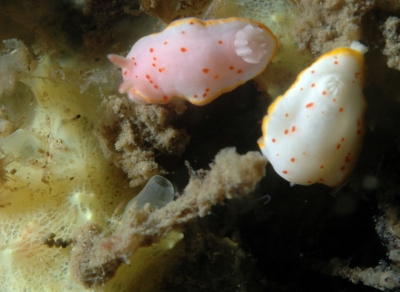
Dear Leanne & David Atkinson,
Thanks for these valuable photos which illustrate quite a few interesting features. Firstly, as I probably say too often, sponge identification can be very tricky, and one reason for this is that colony shape can change considerably even in different parts of the same colony. If you just had the two close-up photos I have included, you might think that the Noumea and the Chromodoris were feeding on different sponges, but as we can see in the upper photo, they are all part of the same colony. It is a species of Darwinella, perhaps an unnamed species. This is a valuable confirmation of the information we already have on both these chromodorid nudibranchs, which suggests they feed on a number of different species of darwinellid sponges, making them a little more flexible in their food choice than those that seem to feed on only one sponge species.
The third interesting feature these photos show is the remarkable similarity in colour pattern between the white N. haliclona and the C. splendida. As I discuss on the Noumea haliclona Fact Sheet there are a large group of chromodorids in south-eastern Australia which all have a similar red-spotted colour pattern, which I suggest is a co-operative warning pattern to deter predators.
Best wishes,
Bill Rudman
Noumea haliclona mating
September 23, 2005
From: Leanne & David Atkinson
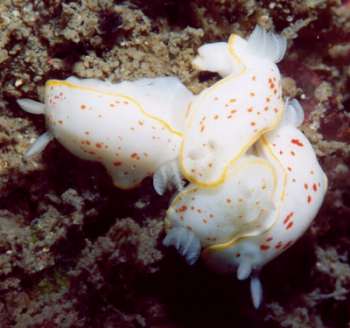
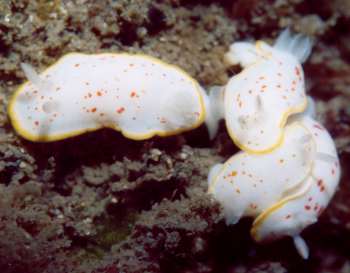
Dear Bill,
We came across this group of tiny nudibranchs at the weekend and think they might be what you've identified for us before as Noumea haliclona. There are faint red/orange spots on the rhinophores when you blow it up. The two shot sequence would indicate that the top two are disengaging from mating while the bottom two are still in the process of mating.
Locality: Pipeline, Port Stephens, NSW, Australia. Depth: 5 metres. Length: 5 mm.18th September 2005. Scattered sponges on sand. Photographer: Leanne & David Atkinson
Regards,
Leanne & David Atkinson
atk@hunterlink.net.au
Leanne & David Atkinson, 2005 (Sep 23) Noumea haliclona mating. [Message in] Sea Slug Forum. Australian Museum, Sydney. Available from http://www.seaslugforum.net/find/14820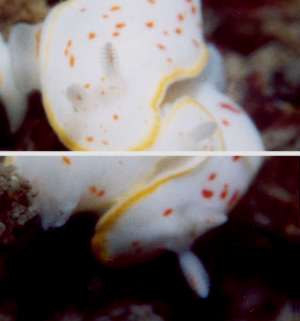
Dear Leanne & David,
Yes this is one of the colour forms of N. haliclona, and as you say, the small reddish marks on the front of the rhinophores are unique to this species, and found in all its colour forms. I agree with your mating scenario.
Best wishes,
Bill Rudman
Noumea haliclona from sthn Queensland
March 4, 2004
From: Gary Cobb
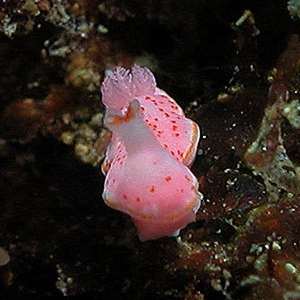
Hi Bill,
Please find another species I can't ID found off Noosa at the north end of the Sunshine Coast, Queensland, Australia.
This one was very small and very bright! The rhinophore are fused together as one. The red dots were not noticeable by the naked eye.
Depth: 16m
Site: Pinnacles
Water temp: 24C
Length: 10mm
Thanks,
Gary
gary@cobb.com.au
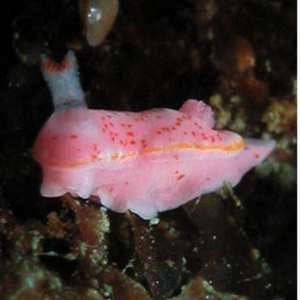
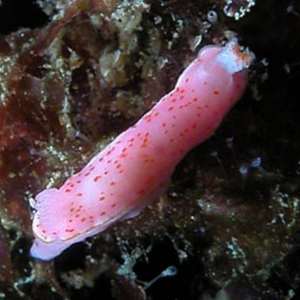
Thanks Gary,
This is one of the New South Wales colour forms of Noumea haliclona. I don't think I have a record from so far north so it's an interesting addition. Actually the red-orange spot on the front of the rhinophore clubs, which is characteristic of this species shows up very clearly on its fused rhinophores
Best wishes
Bill Rudman
Noumea haliclona feeding in Nelson Bay
February 24, 2004
From: Dave Harasti
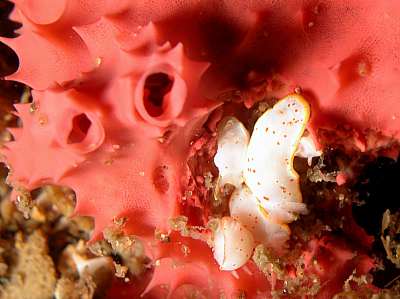
Hi Bill,
After seeing the images from David and Leanne Atkinson the other day [#12234], it prompted me to send you these 2 images of what I think could be Noumea haliclona. I originally though it was a group of Mexichromis festiva feeding on the pink sponge. There was a small group of them (all 1-2 cm) that appear to be feeding on the pink sponge and a single larger individual (about 3 cm) which was nearby.
These images were taken at Little Beach in Nelson Bay, NSW - Australia in January 2003 at about 8 metres. Water temperature was about 22 degrees.
regards,
Dave Harasti
diving@webone.com.au
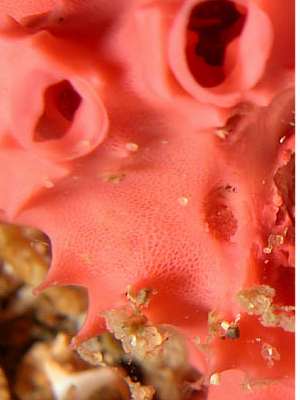
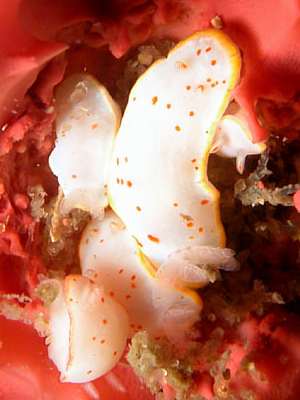
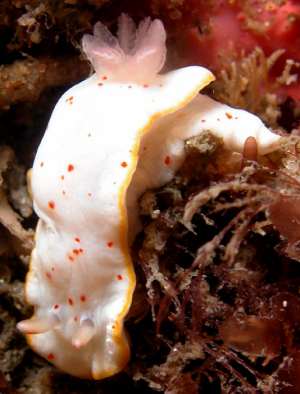
Thanks Dave,
Yes this is one of the
New South Wales colour forms of Noumea haliclona. The sponge is what I have been calling Darwinella gardineri Topsent, 1905. There is a slight chance this name is incorrect because that species is based on New Zealand material but I am checking with my sponge expert. This is one of the two sponges, the other being yellow, which I have found this species on in New South Wales. It is a direct developer, so you often find little groups of small animals together. I presume that when the egg ribbon is laid on their food sponge, which often happens, the young that hatch out as crawling slugs don't need to move very far to find all their requirements.
Best wishes
Bill Rudman
Noumea haliclona feeding
February 16, 2004
From: David & Leanne Atkinson
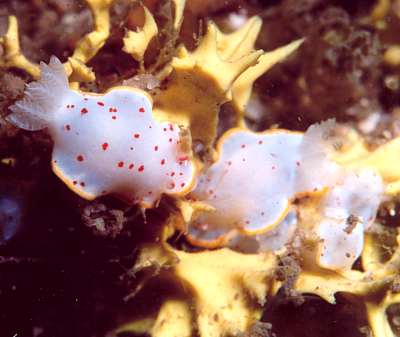
Dear Bill,
Are these nudibranch's Chromodoris hunterae? We found a group of them feeding on a yellow sponge. A few weeks later we found a single individual travelling on sandy bottom [see message #12234].
Location: Halifax Sponge Gardens, Marine Reserve, Port Stephens, NSW, Australia
Date: 17 January 2004 Time: 6:00pm Tide: High 5:05pm
Water Temperature: 20 degrees celcius
Nudibranch size: 5mm Depth: 8m
Thanks for your help,
David & Leanne Atkinson
atk@hunterlink.net.au
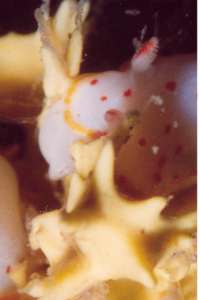
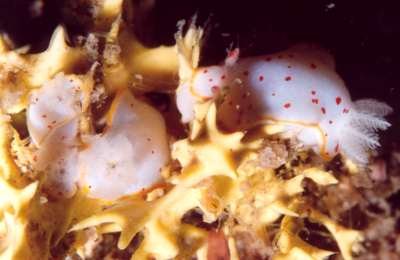
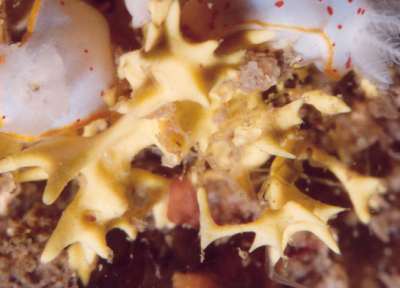
Dear David & Leanne,
I'm afraid I need to put some information on the C. hunterae Fact Sheet. Your animal is one of the New South Wales colour forms of Noumea haliclona. Both it and C. hunterae are members of the 'red-spotted group' colour group of New South Wales chromodorids, and these two species are similar sized and almost identical in external colour. One way you can almost always separate them is that in N. haliclona there is a red mark in the anterior midline of the rhinopore club. You can see it in the small close-up I have included. Usually it is not as prominent as in that photo but it almost always present. All colour forms of Noumea haliclona have this red mark.
Noumea haliclona feeds on a number of related species of Aplysilla, Darwinella and other related species. I haven't seen it on a sponge of quite this colour and shape, but I suspect its a species of Darwinella. Thanks for another valuable piece of information
Best wishes
Bill Rudman
Noumea haliclona from Port Stephens
February 16, 2004
From: David & Leanne Atkinson
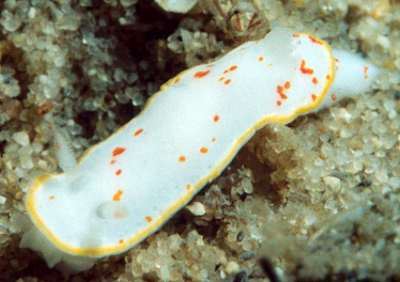
Dear Bill,
To accompany our other message [#12223] here is a photo of a single individual travelling on sandy bottom of the same species we found a few weeks later.
Fly Point Sponge Gardens, Marine Reserve, Port Stephens, NSW, Australia
Date: 8.02.04 Time: 11:00am Tide: High 10:30am
Water Temperature: 17 degrees celcius
Nudibranch size: 5mm Depth: 6m
Thanks for your help,
David & Leanne Atkinson
atk@hunterlink.net.au
David & Leanne Atkinson, D .& L., 2004 (Feb 16) Noumea haliclona from Port Stephens. [Message in] Sea Slug Forum. Australian Museum, Sydney. Available from http://www.seaslugforum.net/find/12234Dear David & Leanne,
Yes this is one of the New South Wales colour forms of Noumea haliclona. You can see a faint red smudge of the front of each rhinophore
Best wishes
Bill Rudman
